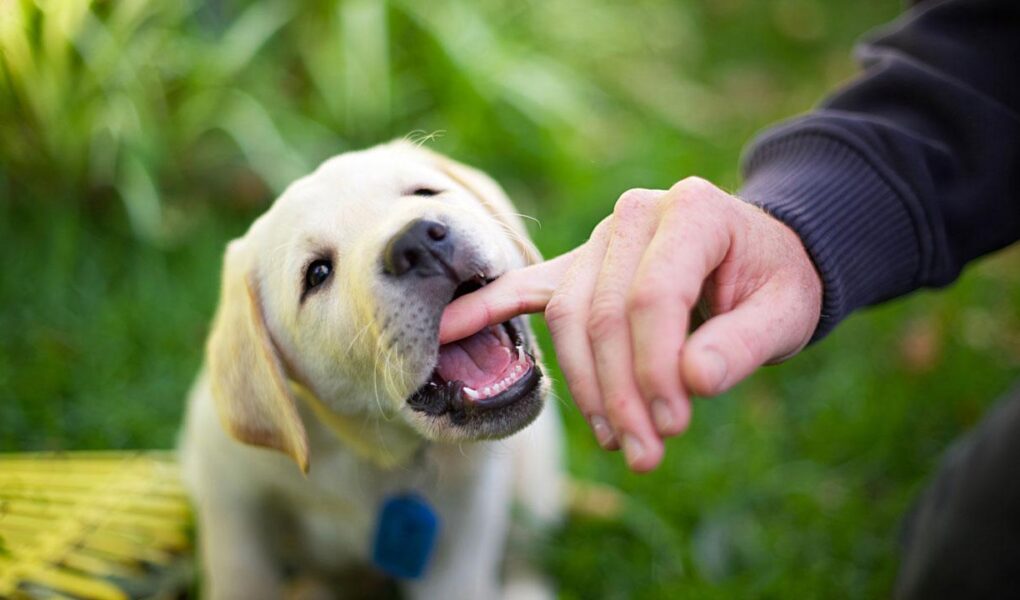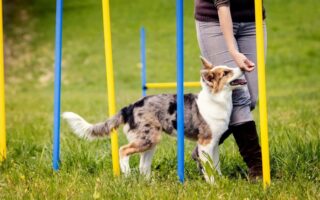Welcoming a puppy into your home is like opening the door to a whirlwind of joy, energy, and boundless curiosity. These adorable bundles of fur quickly become cherished members of the family, bringing laughter and companionship. However, along with their playful antics often comes a common challenge: puppy biting. While it may start as innocent play and a means of exploration, those tiny teeth can quickly lead to frustration and concern. Understanding the reasons behind this behavior, as well as effective strategies to curb it, is essential for fostering a harmonious relationship with your new furry friend. In this article, we’ll explore practical tips and gentle techniques to help you guide your pup towards more appropriate play, ensuring that both of you enjoy this journey together safely and happily.
Table of Contents
- Understanding the Reasons Behind Puppy Biting
- Effective Techniques for Redirection and Reinforcement
- Creating a Positive Environment for Gentle Play
- When to Seek Professional Help for Persistent Biting
- Q&A
- To Wrap It Up
Understanding the Reasons Behind Puppy Biting
Puppy biting is a common behavior that often leaves pet owners perplexed. Understanding the underlying reasons for this instinctual action can be instrumental in addressing it effectively. Puppies bite for various reasons, including the following:
- Teething: Just like human babies, puppies go through a teething phase where their gums become sensitive, prompting them to chew on objects to relieve discomfort.
- Exploration: Puppies are naturally curious. They explore their environment using their mouths, making biting a part of their learning process.
- Play: In the wild, puppies engage in play-fighting with their littermates, which helps them develop social skills. This form of roughhousing often includes gentle biting.
- Attention-seeking: Puppies quickly learn that biting can grab human attention, whether it’s positive or negative, leading them to bite when they want to play or engage with their owners.
To manage and reduce biting behavior, it’s essential to identify the triggers and intervene appropriately. A structured approach can significantly help in guiding your puppy towards more positive behaviors. Consider using the following strategies:
| Strategy | Description |
|---|---|
| Provide Chew Toys | Offering appropriate toys can satisfy the puppy’s urge to bite while alleviating teething discomfort. |
| Redirect Behavior | When biting occurs, redirect the puppy’s attention to a chew toy or engage in a game to divert from inappropriate biting. |
| Consistent Commands | Using a firm “no” or a yelping sound can mimic a littermate’s response and help teach the puppy that biting hurts. |
| Positive Reinforcement | Rewarding the puppy with treats or praise when it plays gently encourages desirable behavior and fosters a positive relationship. |
Effective Techniques for Redirection and Reinforcement
Redirecting your puppy’s biting behavior is essential to building good habits. When your pup starts to nip, immediately divert their attention to an appropriate chew toy or a game of fetch. By doing this, you not only protect your hands but also teach your puppy what is acceptable to bite. It’s important to use vibrant and enticing toys to make the redirection more appealing. Here are some effective strategies to consider:
- Introduce a variety of chew toys with different textures.
- Engage your puppy in interactive games that discourage biting.
- Establish a clear cue, such as “no bite,” followed by a redirect.
- Reward your puppy with praise or treats when they chew on their toys instead.
Reinforcement plays a crucial role in curbing biting behavior. Consistently rewarding positive behavior helps your puppy understand what is expected of them. Implement a consistent reward system where your puppy receives immediate, positive reinforcement when they redirect their energy toward acceptable items. Keep in mind the following to optimize reinforcement:
| Behavior | Immediate Action | Reinforcement |
|---|---|---|
| Redirecting to a toy | Use a favorite chew toy | Praise and treats |
| Playing gently | Engage in calm play | Verbal praise |
| Ignoring nips | Walk away if bitten | Less attention = more value in good behavior |
Creating a Positive Environment for Gentle Play
To encourage your puppy to engage in gentle play, begin by establishing a space that is both safe and comfortable. This environment should be filled with soft toys and chewables that can redirect their biting instincts while also providing a satisfying outlet for their energy. Consider incorporating the following elements:
- Soft bedding: Create a cozy nook where your puppy feels at home.
- Tug toys: Offer sturdy tugging options that promote interactive play without injury.
- Quiet corners: Designate areas where your puppy can retreat when feeling overwhelmed or over-stimulated.
In addition to physical space, incorporating positive reinforcement techniques will help instill gentle behavior over time. Whenever your puppy engages in calm play or chooses toys instead of your hands, reinforce this behavior with treats or praise. A simple tracking table can serve as a motivational tool for both you and your puppy:
| Activity | Reward |
|---|---|
| Playing with a toy | Treat & Praise |
| Gentle interaction | Affection |
| Calm greeting | Playtime |
When to Seek Professional Help for Persistent Biting
If your puppy’s biting behavior becomes persistent and challenging to manage, it may indicate deeper issues that require professional intervention. While playful nips and teething are part of a puppy’s natural development, there are some signs that suggest it’s time to seek guidance from an expert. Consider reaching out if:
- The biting is frequent and aggressive, leading to injury or distress for either your puppy or others.
- Attempts to curb the behavior through training are not yielding results.
- Your puppy exhibits signs of anxiety or fear that contribute to the biting.
- There are sudden changes in biting behavior, such as increased intensity or frequency.
Finding the right professional can make a significant difference in addressing biting issues effectively. When searching for help, look for a trainer or behaviorist who is certified and has experience in dealing with biting and behavioral problems in puppies. It may also be beneficial to consult a veterinarian to rule out any underlying health concerns that could be influencing your puppy’s behavior. Consider the following when reaching out for professional help:
| Criteria | Importance |
|---|---|
| Trainer Certification | Ensures knowledge and experience |
| Behaviorist Specialization | Focuses on behavioral issues |
| Veterinary Consultation | Rules out medical causes |
| Positive Reinforcement Methods | Encourages healthy behavior change |
Q&A
Title: Curbing the Cuties: Your Guide to Stopping Puppy Biting
Q1: Why do puppies bite?
A1: Puppies typically bite as a way of exploring their world. Their mouths are their primary tools for interaction, much like how babies use their hands. Biting can also be a form of play, a way to seek attention, or an expression of excess energy. Understanding the root of this behavior is key to redirecting it.
Q2: Is it normal for my puppy to bite?
A2: Absolutely! Puppy biting is a natural behavior, especially during teething. However, while it’s common, that doesn’t mean it’s acceptable. Teaching your puppy to restrict biting to appropriate outlets is essential for their development and for your continued sanity!
Q3: What should I do when my puppy bites?
A3: When your puppy bites, the first step is to remain calm. Yelling can startle them, reinforcing the biting behavior. Instead, let out a loud “ouch!” or “no!” to signal that the bite was too hard, then redirect their attention to a toy. This way, you’re teaching them boundaries while providing appropriate alternatives.
Q4: How can I teach my puppy to stop biting during playtime?
A4: To manage biting during play, you can implement a “stop and start” game. When your puppy bites too hard, stop the game immediately. Stand still or ignore them for a minute. Once they calm down, you can resume the play. This teaches them that biting leads to an end of fun, while gentle play keeps the fun going.
Q5: Are there specific toys I should use to redirect biting?
A5: Yes, choosing the right kind of toys can be a game changer! Look for durable chew toys, interactive puzzle toys, and soft plush toys that can withstand puppy enthusiasm. Make sure the toys are safe and suited for your puppy’s size so they can chew and gnaw without risk.
Q6: How can socialization help reduce biting?
A6: Socialization is key to teaching your puppy appropriate play behavior. Introducing your puppy to other dogs will help them learn bite inhibition from their peers. They’ll quickly pick up on social cues, such as when their enthusiasm is a bit too intense. Just be sure to supervise the interactions to ensure safety!
Q7: When should I seek professional help for my puppy’s biting?
A7: If biting escalates to aggression, becomes uncontrollable, or if your puppy is consistently causing injury, it might be time to consult with a professional dog trainer or behaviorist. They can provide tailored strategies and support to help you and your puppy find a way to communicate more effectively.
Q8: Can I train my puppy to stop biting on my own?
A8: Definitely! Many pet owners successfully manage puppy biting through patience, consistency, and positive reinforcement. Regular training sessions, along with setting clear boundaries, will empower you to guide your puppy toward mastering the art of gentle play.
Closing Note: Every puppy is unique, and with time, patience, and understanding, you can help your furry friend learn the ropes of gentle affection. Remember, they’re just little bundles of curiosity and energy, learning about the world and how to interact with it—one playful nibble at a time.
To Wrap It Up
navigating the challenges of puppy biting can be both a test of patience and an opportunity for connection. Remember, this behavior is a natural part of your puppy’s development—a way for them to explore their world and communicate. By implementing consistent training strategies, providing appropriate outlets for their energy, and fostering positive interactions, you’ll be on your way to nurturing a well-mannered companion. Each nipping episode is a stepping stone to a deeper bond and understanding between you and your furry friend. Embrace the journey and celebrate the small victories, for they pave the way to a harmonious relationship that will blossom as your puppy grows. With time, love, and dedication, those sharp little teeth will transform into gentle kisses, and you’ll cherish every moment of your adventure together.


